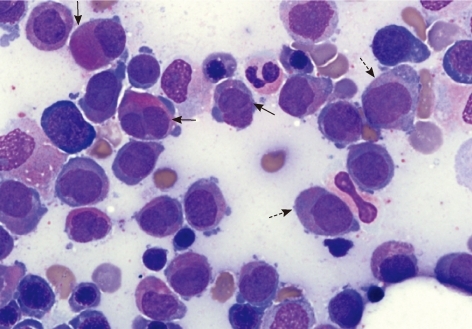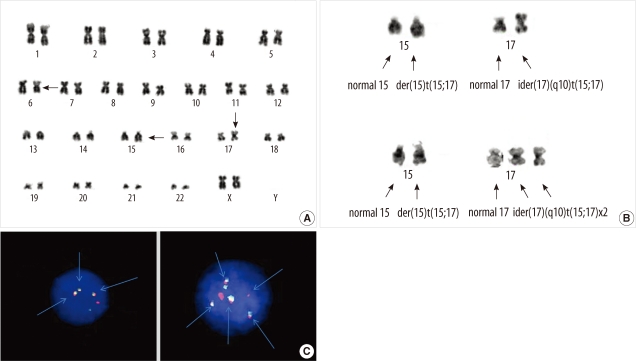Korean J Lab Med.
2011 Apr;31(2):86-90. 10.3343/kjlm.2011.31.2.86.
A Rare Case of Microgranular Acute Promyelocytic Leukemia Associated with ider(17)(q10)t(15;17) in an Old-age Patient
- Affiliations
-
- 1Department of Laboratory Medicine, School of Medicine, Kyung Hee University, Seoul, Korea. 153jesus@hanmail.net
- 2Department of Pediatrics, School of Medicine, Kyung Hee University, Seoul, Korea.
- 3Department of Pathology, School of Medicine, Kyung Hee University, Seoul, Korea.
- 4Department of Hematology-Oncology, School of Medicine, Kyung Hee University, Seoul, Korea. ksamcho@khmc.or.kr
- KMID: 1094345
- DOI: http://doi.org/10.3343/kjlm.2011.31.2.86
Abstract
- We present a rare case of microgranular variant acute promyelocytic leukemia (APL) associated with ider(17)(q10)t(15;17)(q22;q12) of an old-age patient. The initial chromosome study showed a 46,XX,del(6)(?q21q25),der(15)t(15;17)(q22;q12),ider(17)(q10)t(15;17)[10]/47,sl,+ider(17)(q10)t(15;17)[3]/46,XX[16]. FISH signals from a dual color dual fusion translocation PML-RARA probe were consistent with the results of conventional cytogenetics. Because of the rarity of ider(17)(q10)t(15;17) in microgranular APL, further studies on both gene dosage effect of this chromosomal abnormality and the influence of ider(17)(q10)t(15;17) on clinical features such as prognosis, survival, and treatment response of APL cases are recommended.
MeSH Terms
Figure
Reference
-
1. Swerdlow SH, Campo E, editors. WHO classification of tumours of haematopoietic and lymphoid tissues. 2008. 4th ed. Lyon: IARC;p. 112–114.2. Lengfelder E, Saussele S, Weisser A, Büchner T, Hehlmann R. Treatment concepts of acute promyelocytic leukemia. Crit Rev Oncol Hematol. 2005; 56:261–274. PMID: 16236522.
Article3. Sirulnik LA, Stone RM. Acute promyelocytic leukemia: current strategies for the treatment of newly diagnosed disease. Clin Adv Hematol Oncol. 2005; 3:391–397. 429PMID: 16167012.4. Xu L, Zhao WL, Xiong SM, Su XY, Zhao M, Wang C, et al. Molecular cytogenetic characterization and clinical relevance of additional, complex and/or variant chromosome abnormalities in acute promyelocytic leukemia. Leukemia. 2001; 15:1359–1368. PMID: 11516096.
Article5. Hiorns LR, Swansbury GJ, Mehta J, Min T, Dainton MG, Treleaven J, et al. Additional chromosome abnormalities confer worse prognosis in acute promyelocytic leukaemia. Br J Haematol. 1997; 96:314–321. PMID: 9029019.
Article6. Cervera J, Montesinos P, Hernández-Rivas JM, Calasanz MJ, Aventín A, Ferro MT, et al. Additional chromosome abnormalities in patients with acute promyelocytic leukemia treated with all-trans retinoic acid and chemotherapy. Haematologica. 2010; 95:424–431. PMID: 19903674.
Article7. Hernández JM, Martín G, Gutiérrez NC, Cervera J, Ferro MT, Calasanz MJ, et al. Additional cytogenetic changes do not influence the outcome of patients with newly diagnosed acute promyelocytic leukemia treated with an ATRA plus anthracyclin based protocol. A report of the Spanish group PETHEMA. Haematologica. 2001; 86:807–813. PMID: 11522536.8. Chou WC, Tang JL, Yao M, Liang YJ, Lee FY, Lin MT, et al. Clinical and biological characteristics of acute promyelocytic leukemia in Taiwan: a high relapse rate in patients with high initial and peak white blood cell counts during all-trans retinoic acid treatment. Leukemia. 1997; 11:921–928. PMID: 9204969.
Article9. Kaleem Z, Watson MS, Zutter MM, Blinder MA, Hess JL. Acute promyelocytic leukemia with additional chromosomal abnormalities and absence of Auer rods. Am J Clin Pathol. 1999; 112:113–118. PMID: 10396293.
Article10. Manola KN, Karakosta M, Sambani C, Terzoudi G, Pagoni M, Gatsa E, et al. Isochromosome der(17)(q10)t(15;17) in acute promyelocytic leukemia resulting in an additional copy of the RARA-PML fusion gene: report of 4 cases and review of the literature. Acta Haematol. 2010; 123:162–170. PMID: 20224268.11. Kim M, Lee SA, Park HI, Oh EJ, Park CW, Lim J, et al. Two distinct clonal populations in acute promyelocytic leukemia, one involving chromosome 17 and the other involving an isochromosome 17. Cancer Genet Cytogenet. 2010; 197:185–188. PMID: 20193853.
Article12. Sainty D, Liso V, Cantù-Rajnoldi A, Head D, Mozziconacci MJ, Arnoulet C, et al. A new morphologic classification system for acute promyelocytic leukemia distinguishes cases with underlying PLZF/RARA gene rearrangements. Group Français de Cytogénétique Hématologique, UK Cancer Cytogenetics Group and BIOMED 1 European Coomunity-Concerted Acion "Molecular Cytogenetic Diagnosis in Haematological Malignancies.". Blood. 2000; 96:1287–1296. PMID: 10942370.13. Kim MJ, Yoon HS, Cho SY, Lee HJ, Suh JT, Lee J, et al. ider(17)(q10)t(15;17) associated with relapse and poor prognosis in a pediatric patient with acute promyelocytic leukemia. Cancer Genet Cytogenet. 2010; 201:116–121. PMID: 20682396.
Article14. Simmers RN, Webber LM, Shannon MF, Garson OM, Wong G, Vadas MA, et al. Localization of the G-CSF gene on chromosome 17 proximal to the breakpoint in the t(15;17) in acute promyelocytic leukemia. Blood. 1987; 70:330–332. PMID: 2439153.
Article15. Prigogina EL, Fleischman EW, Puchkova GP, Mayakova SA, Volkova MA, Protasova AK, et al. Chromosomes in acute nonlymphocytic leukemia. Hum Genet. 1986; 73:137–146. PMID: 3721500.
Article16. Schoch C, Haase D, Haferlach T, Freund M, Link H, Lengfelder E, et al. Incidence and implication of additional chromosome aberrations in acute promyelocytic leukaemia with translocation t(15;17)(q22;q21): a report on 50 patients. Br J Haematol. 1996; 94:493–500. PMID: 8790148.
Article
- Full Text Links
- Actions
-
Cited
- CITED
-
- Close
- Share
- Similar articles
-
- A case of microgranular variant of acute promyelocytic leukemia with strong positive reaction in nonspecific esterase stain
- A Case of Acute Lymphoblastic Leukemia with ider(9)(q10)t(9;22)(q34;q11.2)
- A case of microgranular acute promyelocytic leukemia
- A case of microgranular acute promyelocytic leukemia with positive reaction of nonspecific esterase
- Detection of PML/RARA Rearrangement by Reverse Transcriptase-PCR and Sequencing in a Case of Microgranular Acute Promyelocytic Leukemia Lacking t(15;17) on Karyotype and FISH



